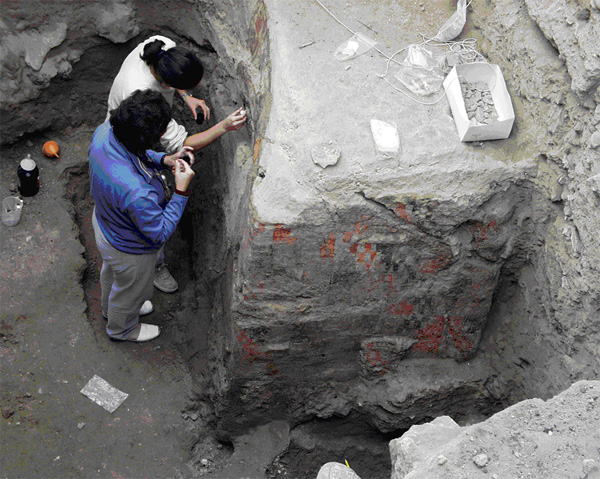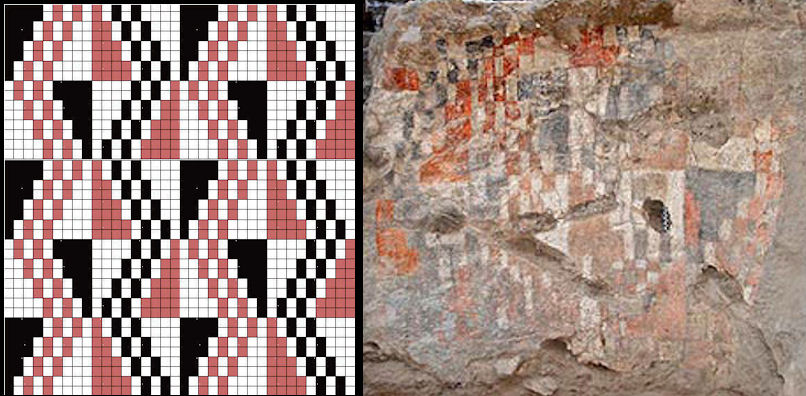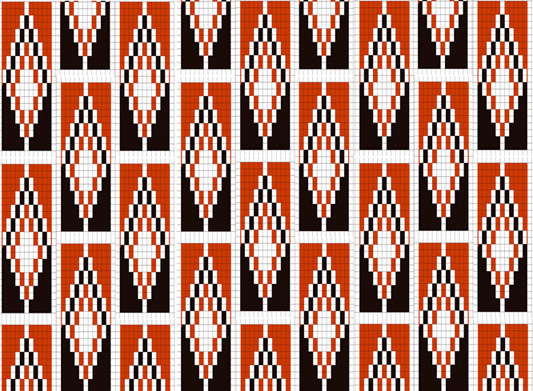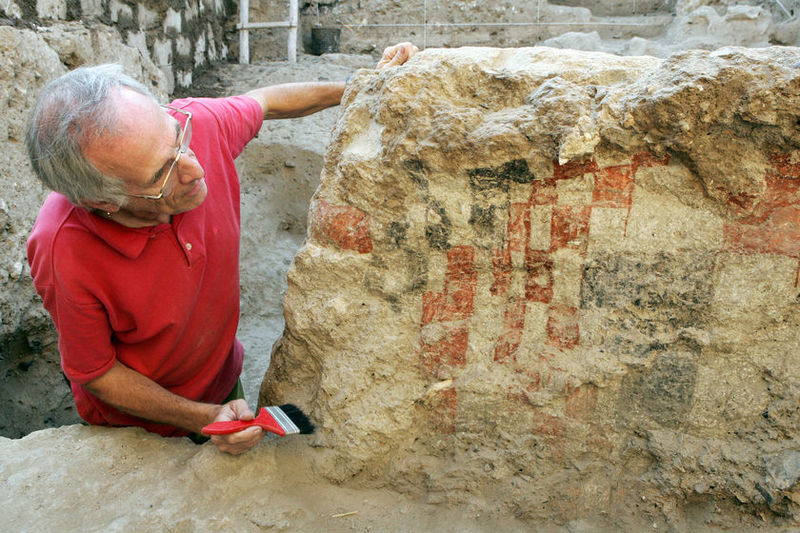It looks like you're using an Ad Blocker.
Please white-list or disable AboveTopSecret.com in your ad-blocking tool.
Thank you.
Some features of ATS will be disabled while you continue to use an ad-blocker.
share:
I hate to be depressive, but the timing of this Syrian discovery could hardly be worse. It reminds me how shortly before the 2003 Iraq invasion
several ancient sites were discovered in Iraq, only to be looted during the current chaos.
However…
At least it’s being documented.
However…
At least it’s being documented.
Originally posted by Danbones
the bodies buried under the buildings indicate at least a few generations of ownership, and maybe even ancestor worship too
I'm not a big fan of the term 'Ancestor Worship'. You mourn the loss of something that is valuable to you, barely notice the passing of something that was commonplace. I think therefore that it is more indicative of the growth of the awareness that some humans were more valuable, because they 'gave' and what they 'gave' was lost upon death. Ancestor Worship therefore, to me, is more indicative of the growth of the awareness that knowledge (and skill) was a communicable, and prized, commodity. But that is purely my opinion. Eventually it would have become a matter of worship, but that is the way of all things the further we remove ourselves from the original source of practice and transform it into belief.
And, burial within the home can be seen as utilitarian, where ground was not suitable for a deep burial, or it would require taking unnecessary risk to transport the bodies to a burial site, it was safer to keep the dead within the confines of the settlement, where they would not attract predators and scavengers. Again, what was once a necessity, will under certain circumstances, become a habit. Either way, it is a highly unhealthy practice, and can perhaps be seen as contributory to why these settlements, where such burials were practiced, had to eventually be abandoned....thus preserving them for our study.
reply to post by Biliverdin
Yet the practice was wide spread leading (probably) to the Asian modern practice of ancestor worship.
Yet the practice was wide spread leading (probably) to the Asian modern practice of ancestor worship.
Originally posted by Hanslune
reply to post by Biliverdin
Yet the practice was wide spread leading (probably) to the Asian modern practice of ancestor worship.
Now, I didn't say it didn't exist, did I? I said that I didn't like the term.
Most ritual at one time had a purpose though. Worship is what is left when the purpose of the ritual has been forgotten.
Originally posted by Hanslune
reply to post by Biliverdin
I was agreeing with you and adding a note !
Ahhh...I apologise, but you are rather subtle in your agreements...
reply to post by Liberal1984
syria?
i believe this site is in turkey
sorry its gobelki tepe thats in turkey my apologies
syria?
i believe this site is in turkey
sorry its gobelki tepe thats in turkey my apologies
edit on 13-3-2012 by GezinhoKiko because: (no reason given)
reply to post by GezinhoKiko
Yes I'm doing a series on the other sites in the area near Gobelki Tepe, which straddle the area on the present day Syrian and Turkish border
Yes I'm doing a series on the other sites in the area near Gobelki Tepe, which straddle the area on the present day Syrian and Turkish border
I made digital reconstruction of the premise for these patterns....




The first pattern was widely publicised at the time of discovery, in 2008, but the second i've sourced only from this funding request.
Second Pattern
Google Translated
That's from the archaeologist working the site, seen here;

Frustratingly, there has been no furthur information about this site for several years now, no photographs of the overall site which includes cyclopean walls, as mentioned in the funding request (the site photo in the OP' is of Jerf al Ahmar) or of any site plan.




The first pattern was widely publicised at the time of discovery, in 2008, but the second i've sourced only from this funding request.
Second Pattern
Google Translated
That's from the archaeologist working the site, seen here;

Frustratingly, there has been no furthur information about this site for several years now, no photographs of the overall site which includes cyclopean walls, as mentioned in the funding request (the site photo in the OP' is of Jerf al Ahmar) or of any site plan.
edit on 24-3-2012 by Kantzveldt because: Added translate link
edit on 24-3-2012 by Kantzveldt because: Comment
reply to post by Hanslune
Star and Flag.
Great opening post to bring us this wonderful discovery. That painting is the mark of intelligence. I love when discoveries like this come to light! Thanks for posting.
Star and Flag.
Great opening post to bring us this wonderful discovery. That painting is the mark of intelligence. I love when discoveries like this come to light! Thanks for posting.
Originally posted by Biliverdin
Originally posted by Danbones
the bodies buried under the buildings indicate at least a few generations of ownership, and maybe even ancestor worship too
I'm not a big fan of the term 'Ancestor Worship'. You mourn the loss of something that is valuable to you, barely notice the passing of something that was commonplace. I think therefore that it is more indicative of the growth of the awareness that some humans were more valuable, because they 'gave' and what they 'gave' was lost upon death. Ancestor Worship therefore, to me, is more indicative of the growth of the awareness that knowledge (and skill) was a communicable, and prized, commodity. But that is purely my opinion. Eventually it would have become a matter of worship, but that is the way of all things the further we remove ourselves from the original source of practice and transform it into belief.
And, burial within the home can be seen as utilitarian, where ground was not suitable for a deep burial, or it would require taking unnecessary risk to transport the bodies to a burial site, it was safer to keep the dead within the confines of the settlement, where they would not attract predators and scavengers. Again, what was once a necessity, will under certain circumstances, become a habit. Either way, it is a highly unhealthy practice, and can perhaps be seen as contributory to why these settlements, where such burials were practiced, had to eventually be abandoned....thus preserving them for our study.
the reasons for ancestor worship are the spirits of the ancestors...
Ancestor worship occurs in ancient cultures all over the world, and even in modern times it plays an important role in primitive religions. It is founded on the belief that the dead live on and are able to influence the lives of later generations. These ancestors can assert their powers by blessing or cursing, and their worship is inspired by both respect and fear. The ancestor cult consists of praying, presenting gifts, and making offerings. In some cultures, people try to get their ancestors' advice through oracles before making important decisions.
In ancient China and Egypt, the influence of ancestors was very great.
They were buried in expensive graves and in Egypt a permanent death cult was instituted. It was generally believed that the lack of veneration would cause the deceased to die a second death, which was for many people an almost unbearable thought.
In nearly every primitive tribal religions of Africa ancestor worship is common practice. The ancestors of the tribe are honored as spirits who preserve the moral standards of tribal life. They are also regarded as the intermediaries between the living and the divine powers. And the ancestor spirits play an important role in the initiation rites. Among some west-African peoples the belief is current that the ancestors reincarnate in their descendants.
In Japan, ancestors were worshipped until 1945. At that time, the Japanese Emperor disclaimed any form of divine ancestry and polytheistic ancestor worship was no longer permitted.
www.pantheon.org...
funny how it was practiced in so many distant places that were independant of each other as opposed to say christianity which is spread by contact and conquest
Even in the BOOK OF ENOCH does this veneration and intermediary influence appear
and that book is an account of that time and place
The Celts buried thier dead the same way: under the house and they worshiped ancestors too
en.wikipedia.org...
Its interesting how the patterns are remenicent of North American abouriginal art...
I wonder what else might be..like possibly the construction methods?
www.world-mysteries.com...
Navaho rug pattern
www.free-beading-patterns.com...
even more better here
www.free-beading-patterns.com...
I wonder what else might be..like possibly the construction methods?
In 1997, a fifth mtDNA haplogroup was identified in Native Americans, This group, called ‘"X," is present in three percent of living Native Americans. Haplogroup X was not then found in Asia, but was found only in Europe and the Middle East
www.world-mysteries.com...
Navaho rug pattern
www.free-beading-patterns.com...
even more better here
www.free-beading-patterns.com...
edit on 24-3-2012 by Danbones because: (no reason given)
It seems to me there are a lot of basic similarities to other cultures as if there was a spreading of this influence
www.ocf.berkeley.edu...
The floor of rooms other than the kiva would generally be plastered rather than covered with stone slabs. The interior of the walls would be plastered as well, and frequently painted with designs.....
By 1000 C.E., the Anasazi had advanced to stone construction...
...In addition to the above-ground rooms, a site would have one or more kivas, underground chambers, which are assumed, by parallel with kivas in modern pueblos, to be of ritual use. The kiva would be a circular pit, with walls of the same construction as the above ground rooms, extending a short distance above ground. The floor would be paved in stone slabs, and entrance would be through the roof. The area directly around the entrance would frequently be finished in stone as well, possibly to reduce the amount of wear on the entrance. There would be a hearth inside, with an altar on the other side of the hearth facing the wall. The wall nearest the hearth would have a ventilation opening near the bottom. With an opening at the ground and in the roof, the fire would set up air currents which would provide good ventilation. There would be a bench running around the perimeter of the kiva
Originally posted by Kantzveldt
I made digital reconstruction of the premise for these patterns....
Frustratingly, there has been no furthur information about this site for several years now, no photographs of the overall site which includes cyclopean walls, as mentioned in the funding request
Very good reconstruction - so a decorative pattern. Have you tried contacting the main excavators?
Yes that image is for the wrong site (sorry about that)
edit on 24/3/12 by Hanslune because: (no reason given)
reply to post by Hanslune
Not yet, i've thought about offering my reconstructions to the lead archaeologist, i can source his email, and asking for furthur information particularly regarding the patterns.
Not yet, i've thought about offering my reconstructions to the lead archaeologist, i can source his email, and asking for furthur information particularly regarding the patterns.
reply to post by Danbones
The Navaho correspondnce to the pattern methodology is very good, i've also been looking at strong similaraties from the Andean region that seemed to peak around the time of Tiahuanaco/Puma Punku era,.
Paracas and Inca pattern
Now the general context for those is known, with regards to Chakana symbolism, the meeting point of the Celestial/terrestial/underworld realms, and that would also be my best guess for the colour symbolism of the Neolitihc paintings, white/celestial red/terrestial black/underworld.
The Navaho correspondnce to the pattern methodology is very good, i've also been looking at strong similaraties from the Andean region that seemed to peak around the time of Tiahuanaco/Puma Punku era,.
Paracas and Inca pattern
Now the general context for those is known, with regards to Chakana symbolism, the meeting point of the Celestial/terrestial/underworld realms, and that would also be my best guess for the colour symbolism of the Neolitihc paintings, white/celestial red/terrestial black/underworld.
reply to post by Hanslune
Question is why didn't it continue to look nice and maybe a whole lot nicer through subsequent generations, why did these carefully contrived and executed patterns degenerate into the various scribbled squiggles, zany zigzags and lazy lozenges haphazardly seen on bone, stone and figurine through the subsequent millenia of the Neolithic period...the same that could be said of the fine constructions at Nevali Cori and Gobekli Tepe...the early Neolithic was the 'nicest'.
Question is why didn't it continue to look nice and maybe a whole lot nicer through subsequent generations, why did these carefully contrived and executed patterns degenerate into the various scribbled squiggles, zany zigzags and lazy lozenges haphazardly seen on bone, stone and figurine through the subsequent millenia of the Neolithic period...the same that could be said of the fine constructions at Nevali Cori and Gobekli Tepe...the early Neolithic was the 'nicest'.
edit on 25-3-2012 by Kantzveldt because: typo
Originally posted by Kantzveldt
reply to post by Hanslune
Question is why didn't it continue to look nice and maybe a whole lot nicer through subsequent generations, why did these carefully contrived and executed patterns degenerate into the various scribbled squiggles, zany zigzags and lazy lozenges haphazardly seen on bone, stone and figurine through the subsequent millenia of the Neolithic period...the same that could be said of the fine constructions at Nevali Cori and Gobekli Tepe...the early Neolithic was the 'nicest'.
I'd say that it did but only at this site did the relatively 'soft' evidence of such survive. Perhaps the colour scheme was transferred to textile which haven't survive or more realistic, the fads of the time grew tired of x and switch to y
edit on 25/3/12 by Hanslune because: (no reason
given)
reply to post by Hanslune
There are numerous examples at Catal Hoyuk of geometric pattern murals, which while being several thousand years later aren't as sophisticated or well executed, the figurative elements from that site are highly interesting though.
Catal Hoyuk Murals
A case can be made for the D'jade patterns being the formative basis for the abstract pattern making seen throughout the Neolithic period, including Catal Hoyuk, just never again seen as fully or well developed.
There are numerous examples at Catal Hoyuk of geometric pattern murals, which while being several thousand years later aren't as sophisticated or well executed, the figurative elements from that site are highly interesting though.
Catal Hoyuk Murals
A case can be made for the D'jade patterns being the formative basis for the abstract pattern making seen throughout the Neolithic period, including Catal Hoyuk, just never again seen as fully or well developed.
new topics
-
Israel attacking Iran again.
Middle East Issues: 58 minutes ago -
Michigan school district cancels lesson on gender identity and pronouns after backlash
Education and Media: 1 hours ago -
When an Angel gets his or her wings
Religion, Faith, And Theology: 1 hours ago -
Comparing the theology of Paul and Hebrews
Religion, Faith, And Theology: 2 hours ago -
Pentagon acknowledges secret UFO project, the Kona Blue program | Vargas Reports
Aliens and UFOs: 3 hours ago -
Boston Dynamics say Farewell to Atlas
Science & Technology: 3 hours ago -
I hate dreaming
Rant: 4 hours ago -
Man sets himself on fire outside Donald Trump trial
Mainstream News: 6 hours ago -
Biden says little kids flip him the bird all the time.
Politicians & People: 6 hours ago -
The Democrats Take Control the House - Look what happened while you were sleeping
US Political Madness: 7 hours ago
top topics
-
The Democrats Take Control the House - Look what happened while you were sleeping
US Political Madness: 7 hours ago, 17 flags -
In an Historic First, In N Out Burger Permanently Closes a Location
Mainstream News: 9 hours ago, 14 flags -
A man of the people
Medical Issues & Conspiracies: 14 hours ago, 10 flags -
Biden says little kids flip him the bird all the time.
Politicians & People: 6 hours ago, 8 flags -
Man sets himself on fire outside Donald Trump trial
Mainstream News: 6 hours ago, 7 flags -
Pentagon acknowledges secret UFO project, the Kona Blue program | Vargas Reports
Aliens and UFOs: 3 hours ago, 5 flags -
4 plans of US elites to defeat Russia
New World Order: 16 hours ago, 4 flags -
Sheetz facing racial discrimination lawsuit for considering criminal history in hiring
Social Issues and Civil Unrest: 7 hours ago, 3 flags -
Boston Dynamics say Farewell to Atlas
Science & Technology: 3 hours ago, 3 flags -
Are you ready for the return of Jesus Christ? Have you been cleansed by His blood?
Religion, Faith, And Theology: 11 hours ago, 3 flags
active topics
-
The Acronym Game .. Pt.3
General Chit Chat • 7733 • : CCoburn -
A man of the people
Medical Issues & Conspiracies • 11 • : chr0naut -
Post A Funny (T&C Friendly) Pic Part IV: The LOL awakens!
General Chit Chat • 7128 • : baddmove -
Michigan school district cancels lesson on gender identity and pronouns after backlash
Education and Media • 5 • : MetalThunder -
Thousands Of Young Ukrainian Men Trying To Flee The Country To Avoid Conscription And The War
Other Current Events • 52 • : TheMisguidedAngel -
-@TH3WH17ERABB17- -Q- ---TIME TO SHOW THE WORLD--- -Part- --44--
Dissecting Disinformation • 547 • : 777Vader -
Israel attacking Iran again.
Middle East Issues • 14 • : Solvedit -
The Democrats Take Control the House - Look what happened while you were sleeping
US Political Madness • 64 • : KrustyKrab -
Candidate TRUMP Now Has Crazy Judge JUAN MERCHAN After Him - The Stormy Daniels Hush-Money Case.
Political Conspiracies • 403 • : Threadbarer -
Cat Movies
Movies • 19 • : 5thHead
